Build is now complete but not finished off. Some pictures.
This shows the bracing.
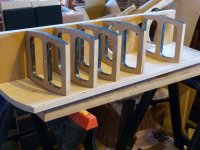
Hole for woofer, champhered
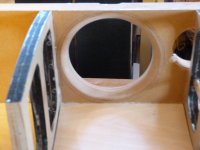
soundpfoofing, trimmed to allow woofer to breathe
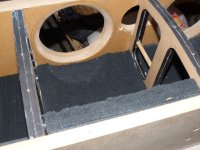
Shows soundproofing on one side
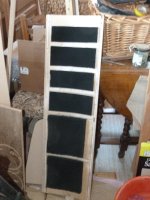
The port, flared piece on outside

Soundproofing on the base
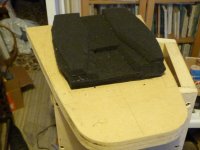
soundproofing on base showing it cut away to allow port to breathe
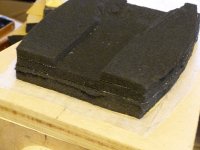
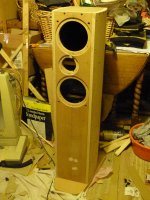
At last, one finished
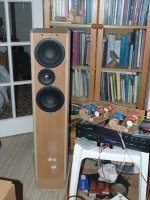
The system
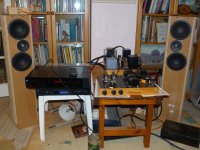
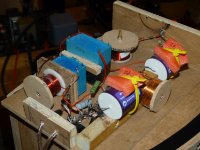
The lovely 300B SET amp.
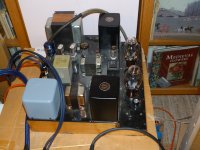
Some notes.
Sides are 1000mm high, width is 210mm at front and rear, curved to 244mm max. Depth is 288mm.
Sides are 20mm thick, laminated 4mm birch ply x 3 and 4mm MDF x2, ply/mdf/ply/mdf/ply.
Front is 30mm MDF, rear and top 18mm MDF, base 3 laminations of 9mm MDF.
Soundproofer:
inside the top, 25mm and 12mm open foam, cut to allow woofer to breathe
inside the top section where the drivers are: 25mm foam on sides, 5mm EPDM and 25mm foam on rear.
inside the lower section: 5mm EPDM on rear, 12mm foam on sides.
inside the base: 25mm foam plus 2 layers 12mm foam, trimmed to allow port to breathe.
Assembly done with coarse thread drywall screws which work well into MDF and ply end grain, with generous counterbore.
The system is a test setup with a spare valve preamp and 300B SET amp; the amp is good, with separate PSUs for the two stages, multiple chokes in each stage, massive power transformer and very nice Hashimoto OPTs.
The crossovers look messy but are done so as to allow easy changing of components.
This shows the bracing.

Hole for woofer, champhered

soundpfoofing, trimmed to allow woofer to breathe

Shows soundproofing on one side

The port, flared piece on outside

Soundproofing on the base

soundproofing on base showing it cut away to allow port to breathe


At last, one finished

The system


The lovely 300B SET amp.

Some notes.
Sides are 1000mm high, width is 210mm at front and rear, curved to 244mm max. Depth is 288mm.
Sides are 20mm thick, laminated 4mm birch ply x 3 and 4mm MDF x2, ply/mdf/ply/mdf/ply.
Front is 30mm MDF, rear and top 18mm MDF, base 3 laminations of 9mm MDF.
Soundproofer:
inside the top, 25mm and 12mm open foam, cut to allow woofer to breathe
inside the top section where the drivers are: 25mm foam on sides, 5mm EPDM and 25mm foam on rear.
inside the lower section: 5mm EPDM on rear, 12mm foam on sides.
inside the base: 25mm foam plus 2 layers 12mm foam, trimmed to allow port to breathe.
Assembly done with coarse thread drywall screws which work well into MDF and ply end grain, with generous counterbore.
The system is a test setup with a spare valve preamp and 300B SET amp; the amp is good, with separate PSUs for the two stages, multiple chokes in each stage, massive power transformer and very nice Hashimoto OPTs.
The crossovers look messy but are done so as to allow easy changing of components.
Noe about the sound.
First 3 things to mention, long and rambling, sorry.
Builders bias: I have this, I try to allow for it.
When I make a valve unit, if if powers up OK; if the supply voltage is right; if all the valves work at their right operating points; if it doesn't make funny noises; if it gives some kind of audio signal; then I'm very happy, on a high, and no way can I make an objective evaluation of the sound. Natural really.
I have run the speakers for well over a week now so I may be over 'builders bias' but hard to say.
A parallel with winemaking. Eh?? I did some many years ago, not an expert, but I found this.
You can get all the right ingredients after fermentation, alcohol, fruit, tannin, acid, sugar, whatever; but is certainly is not wine! Leave it in the bottle for a year and it might be. The best way to know the difference is to taste it!
Perhaps an ingredient is missing or wrong, it might still end up as wine, but not that great; even so, it could be bet much better than something technically perfect that isn't wine. Knowing the technicalities will help improve on it.
Strong parallels to hifi, perhaps? Measurements will prove all the deficiencies of my SET amps, but I assure you they are wine!
I am expecting measurement to help me improve the speakers; but I don't believe measurements can tell if there is beauty in the music.
Reference systems.
Sources in all 3 systems are very similar, CD players with TDA1541A chip (2 Marantz and a Sugden), reworked with a lot of capacitor upgrades, converted to non-oversampling, better clocks, and with valve output stages. All very similar and very good; Sugden is best but all have excellent tonality, and a good top end without any harshness.
The main system is valve preamp and 45 parallel single ended power amp with far more subjective power than you could expect.
Speakers are the Seas MTM and 27TDFC MTM mentioned before.
The headphone system uses a valve OTL amp of mine with ZMF Verite Open phones; as these are 300 ohm they match an OTL amp well. Superb phones, with guess what, beryllium cones. The amp is good; headphone amps are harder than you'd expect, I have made about 7, this one is good.
This headphone system seems the best reference system for comparisons.
The sound.
This was all in the upstairs system, a bit of a lashup, the good 300B amp and a valve preamp like the one downstairs. Poor interconnects and mains cable to the speakers; I rarely ever used this system.
To start with I used a Tascam CD player.
At first it had most things there, bass a bit light but otherwise freq response seemed OK, did nothing wrong. But it wasn't wine.
3 days and about 30 hours later it was making music, improved a lot with this running in. More bass and it was decent, tight fast and tuneful, but not quite enough of it. Vocals were very good; male and female, sung and spoken, so I believe the crossover was OK. Top end perhaps a bit too much? No changes made as running in was not finished.
A couple of days later I fitted better interconnects (the top Van Damme and a DIY Neotech 3001/KLE copper plugs), also Van Damme 4sq mm speaker cable of high quality; I also changed to the Sugden CD player.
Things improved in many ways but seemed like too much top end. I carried on running things in and listening.
A lot was good; bass tight fast and tuneful; great clarity to everything; very precise placement of vocalists; some vocals very enjoyable, some not; transients fast and dramatic; classical music superb. But on balance, not wine.
Though it would be easy to change the dropper R in the crossover, I decided to leave as is and take measurements, so I ordered a mic and lead. I am concerned that changing this R, and perhaps changing the BSC, might affect the crossover's main function in a way I did not understand; better I think to measure it as is, work out the changes needed, and model the crossover again to allow for all these changes while working exactly as it is now in the crossover region as this is good.
Then I had an idea; as the crossover is external, it was easy to knock up banana plugs and sockets and 0.91ohm resistors to insert between the crossover and the tweeter input on the speakers. Result ... the wine was back. Very enjoyable music, very much matching the headphone system.
I know it's not yet right, but it is close. Measuring, listing and correlating the two should indicate what changes to try, hopefully small. But there is a whole lot that is right already. Bass is high quality (not always the case with SET amps but I engineered it). Clarity, transparency excellent. Good volume, may I expand on this. After listening I usually left it on repeat and go downstairs, often I was surprised how loud it seemed downstairs even with TV on. So I think I was playing it fairly loud without realising it, which can be the case when distortion is low. Suggests to me that the distortion really is low.
Also, the volume with a low power SET amp is very good indeed, absolutely fine for me. Highly recommended for SETs.
Transients, things hit, strings plucked firmly, very good. Tonality of voices very good (with Tascam or with the added resistor) and I am very sensitive to this.
I'm already hearing some of the things that make the Salk Bepure 2 so good; but I'm sure I can get more and I know how to go about it. The bass tuning and many aspects of the crossover are good, distortion is low, clarity excellent, imaging very good (much better than the SEAS MTMs).
One thing I will try is this. The port is tuned very low, 24Hz. The bass was modelled in Winisd after correcting Q for my amp, this low tuning avoids a hump in the 60-100Hz region and gives good group delay. But the speaker is partly reflex, partly MLTL I guess; so a slightly different tuning may work well. I will try 27Hz which seems OK and brings the bass up a bit. Balancing this and BSC will be fun I think!
Some music and comments:
Cassandra Wilson, Blue Light till Dawn; used as lot as it is well recorded, acoustic, a whole lot going on, fast transients, excellent voice (though not all the songs are good). Good bass; plucked and bowed acoustic bass. Quite a bit of top end. A good test CD, anything not right shows up, great when it is right.
Inger Marie Gundersen, Make this Moment; Fool on the Hill (in a post here) is excellent; beautiful delicate voice; it showed up the top end problem. If this is not enjoyable, it means there is a problem. I think still a slight edge to the vocals, top needs work, must ensure I don't spoil the sound of most music to get just one correct.
Paul Simon, Graceland. His voice comes over very well indeed in terms of realism, 'he is there' effect. Homeless is amazing, shows there is no problem with lower male voice.
Clair Marlo, Let it Go, Sheffield Lab. Very enjoyable via the Tascam, not so much via Sugden etc before the R mod, not tried with the R mod; but a whole lot right about the sound.
Mozart, Piano concertos 9 20 21 23 27, ECO, Barenbiom, EMI. Very good indeed - with Sugden, before R mod; fine piano sound, good dynamics, fine tonality.
Morgan James Live. Heard on all 3 setups, excellent. Spoken voice fine. Fine tonality and realism with the R mod. Important IMO to use w.ll recorded live music for evaluation, this is well recorded. 'Funkier than a mosquito's tweeter' amazing. This test passed!
Laurie Allyn, Paradise. Excellently recorded vocals, comes across really well on all setups; with R mod, very close indeed to the headphone system.
So I'm getting there and above all, two things.
It has been, and continues to be, a great fun project that I am enjoying so much.
If I really get there (and I think I will), it will be a lot more; many have speculated about a Purifi/Be MTM, how good it could be; I think it will be much more significant than a fun project.
Thanks for support.
Sorry this is long, could have said it in half the words but what's the fun in that?
Mike
First 3 things to mention, long and rambling, sorry.
Builders bias: I have this, I try to allow for it.
When I make a valve unit, if if powers up OK; if the supply voltage is right; if all the valves work at their right operating points; if it doesn't make funny noises; if it gives some kind of audio signal; then I'm very happy, on a high, and no way can I make an objective evaluation of the sound. Natural really.
I have run the speakers for well over a week now so I may be over 'builders bias' but hard to say.
A parallel with winemaking. Eh?? I did some many years ago, not an expert, but I found this.
You can get all the right ingredients after fermentation, alcohol, fruit, tannin, acid, sugar, whatever; but is certainly is not wine! Leave it in the bottle for a year and it might be. The best way to know the difference is to taste it!
Perhaps an ingredient is missing or wrong, it might still end up as wine, but not that great; even so, it could be bet much better than something technically perfect that isn't wine. Knowing the technicalities will help improve on it.
Strong parallels to hifi, perhaps? Measurements will prove all the deficiencies of my SET amps, but I assure you they are wine!
I am expecting measurement to help me improve the speakers; but I don't believe measurements can tell if there is beauty in the music.
Reference systems.
Sources in all 3 systems are very similar, CD players with TDA1541A chip (2 Marantz and a Sugden), reworked with a lot of capacitor upgrades, converted to non-oversampling, better clocks, and with valve output stages. All very similar and very good; Sugden is best but all have excellent tonality, and a good top end without any harshness.
The main system is valve preamp and 45 parallel single ended power amp with far more subjective power than you could expect.
Speakers are the Seas MTM and 27TDFC MTM mentioned before.
The headphone system uses a valve OTL amp of mine with ZMF Verite Open phones; as these are 300 ohm they match an OTL amp well. Superb phones, with guess what, beryllium cones. The amp is good; headphone amps are harder than you'd expect, I have made about 7, this one is good.
This headphone system seems the best reference system for comparisons.
The sound.
This was all in the upstairs system, a bit of a lashup, the good 300B amp and a valve preamp like the one downstairs. Poor interconnects and mains cable to the speakers; I rarely ever used this system.
To start with I used a Tascam CD player.
At first it had most things there, bass a bit light but otherwise freq response seemed OK, did nothing wrong. But it wasn't wine.
3 days and about 30 hours later it was making music, improved a lot with this running in. More bass and it was decent, tight fast and tuneful, but not quite enough of it. Vocals were very good; male and female, sung and spoken, so I believe the crossover was OK. Top end perhaps a bit too much? No changes made as running in was not finished.
A couple of days later I fitted better interconnects (the top Van Damme and a DIY Neotech 3001/KLE copper plugs), also Van Damme 4sq mm speaker cable of high quality; I also changed to the Sugden CD player.
Things improved in many ways but seemed like too much top end. I carried on running things in and listening.
A lot was good; bass tight fast and tuneful; great clarity to everything; very precise placement of vocalists; some vocals very enjoyable, some not; transients fast and dramatic; classical music superb. But on balance, not wine.
Though it would be easy to change the dropper R in the crossover, I decided to leave as is and take measurements, so I ordered a mic and lead. I am concerned that changing this R, and perhaps changing the BSC, might affect the crossover's main function in a way I did not understand; better I think to measure it as is, work out the changes needed, and model the crossover again to allow for all these changes while working exactly as it is now in the crossover region as this is good.
Then I had an idea; as the crossover is external, it was easy to knock up banana plugs and sockets and 0.91ohm resistors to insert between the crossover and the tweeter input on the speakers. Result ... the wine was back. Very enjoyable music, very much matching the headphone system.
I know it's not yet right, but it is close. Measuring, listing and correlating the two should indicate what changes to try, hopefully small. But there is a whole lot that is right already. Bass is high quality (not always the case with SET amps but I engineered it). Clarity, transparency excellent. Good volume, may I expand on this. After listening I usually left it on repeat and go downstairs, often I was surprised how loud it seemed downstairs even with TV on. So I think I was playing it fairly loud without realising it, which can be the case when distortion is low. Suggests to me that the distortion really is low.
Also, the volume with a low power SET amp is very good indeed, absolutely fine for me. Highly recommended for SETs.
Transients, things hit, strings plucked firmly, very good. Tonality of voices very good (with Tascam or with the added resistor) and I am very sensitive to this.
I'm already hearing some of the things that make the Salk Bepure 2 so good; but I'm sure I can get more and I know how to go about it. The bass tuning and many aspects of the crossover are good, distortion is low, clarity excellent, imaging very good (much better than the SEAS MTMs).
One thing I will try is this. The port is tuned very low, 24Hz. The bass was modelled in Winisd after correcting Q for my amp, this low tuning avoids a hump in the 60-100Hz region and gives good group delay. But the speaker is partly reflex, partly MLTL I guess; so a slightly different tuning may work well. I will try 27Hz which seems OK and brings the bass up a bit. Balancing this and BSC will be fun I think!
Some music and comments:
Cassandra Wilson, Blue Light till Dawn; used as lot as it is well recorded, acoustic, a whole lot going on, fast transients, excellent voice (though not all the songs are good). Good bass; plucked and bowed acoustic bass. Quite a bit of top end. A good test CD, anything not right shows up, great when it is right.
Inger Marie Gundersen, Make this Moment; Fool on the Hill (in a post here) is excellent; beautiful delicate voice; it showed up the top end problem. If this is not enjoyable, it means there is a problem. I think still a slight edge to the vocals, top needs work, must ensure I don't spoil the sound of most music to get just one correct.
Paul Simon, Graceland. His voice comes over very well indeed in terms of realism, 'he is there' effect. Homeless is amazing, shows there is no problem with lower male voice.
Clair Marlo, Let it Go, Sheffield Lab. Very enjoyable via the Tascam, not so much via Sugden etc before the R mod, not tried with the R mod; but a whole lot right about the sound.
Mozart, Piano concertos 9 20 21 23 27, ECO, Barenbiom, EMI. Very good indeed - with Sugden, before R mod; fine piano sound, good dynamics, fine tonality.
Morgan James Live. Heard on all 3 setups, excellent. Spoken voice fine. Fine tonality and realism with the R mod. Important IMO to use w.ll recorded live music for evaluation, this is well recorded. 'Funkier than a mosquito's tweeter' amazing. This test passed!
Laurie Allyn, Paradise. Excellently recorded vocals, comes across really well on all setups; with R mod, very close indeed to the headphone system.
So I'm getting there and above all, two things.
It has been, and continues to be, a great fun project that I am enjoying so much.
If I really get there (and I think I will), it will be a lot more; many have speculated about a Purifi/Be MTM, how good it could be; I think it will be much more significant than a fun project.
Thanks for support.
Sorry this is long, could have said it in half the words but what's the fun in that?
Mike
Some measured frequency response plots.
From early listening, I noted the bass was low and the treble high so I tried increasing the woofer inductor and adding another dropper R on the tweeter.
Results with 0.62mH on the bass, and different droppers. Pay no attention to the values, I was not good at REW setup.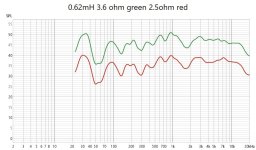
The bass still seemed somewhat low, hence another try.
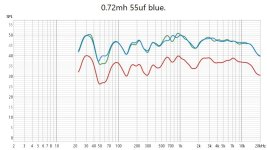
This sounded pretty good.
Setting the BSC was a bit erratic as measurement, modelling and listening did not agree that well; bass sounded more than expected from the measurements.
Next I tried more BSC, and more dropper R on the tweeter.
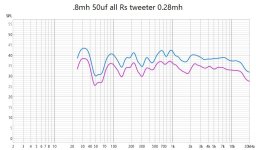
Xsim suggested that the cap could be lowered from 55uF to 50uF with the inductor of 0.8mH. This 0.8 was more than I had expected, but I used 1.2mH with the SEAS drivers in my earlier MTM, so perhaps it is not excessive.
The red line is with 0.23mH on the tweeter (as all the above). Modelling suggested that increasing it might reduce the dip at 1800Hz so I tried 0.28mH, the blue line.
The bass came up and seemed very good in quality and amount; I assessed this with music I know, and with Dire Straits on the headphone system and SEAS system as well. The sound was good in every way on lots of music; great focus, transparency, sweet when the music was sweet, musical, great transients.
Cassandra Wilson sounding very good her and the musicians.
I do intend to try 0.72 again, perhaps with 50uF.
Wait for the 'but'.
And here it is.
While assessing the bass, listening on the old SEAS speakers downstairs, I really noticed how great the rock guitar was on 6 Bladed Knife; really good tone, plenty of whine, lots of character, just great sounding.
But upstairs on the new speakers, it simply was not as good; almost as if some of it was missing. Shame, as with BSC pretty much sorted, many aspects of the sound were really good.
The FR plots are not perfect but seem reasonable, I don't think they explain the issue. Caps on the tweeter are midrange Claritycaps, not the best but I don't think they can be to blame.
Very likely it's the amp, the 45 PSE downstairs is very good, but the 300B SET is a good one.
I'll have to check out the CD player and swap a few things around to find the reason; I've already reduced the dropper on the tweeter with no significant result.
Any comments on the FR plots welcomed.
From early listening, I noted the bass was low and the treble high so I tried increasing the woofer inductor and adding another dropper R on the tweeter.
Results with 0.62mH on the bass, and different droppers. Pay no attention to the values, I was not good at REW setup.

The bass still seemed somewhat low, hence another try.

This sounded pretty good.
Setting the BSC was a bit erratic as measurement, modelling and listening did not agree that well; bass sounded more than expected from the measurements.
Next I tried more BSC, and more dropper R on the tweeter.

Xsim suggested that the cap could be lowered from 55uF to 50uF with the inductor of 0.8mH. This 0.8 was more than I had expected, but I used 1.2mH with the SEAS drivers in my earlier MTM, so perhaps it is not excessive.
The red line is with 0.23mH on the tweeter (as all the above). Modelling suggested that increasing it might reduce the dip at 1800Hz so I tried 0.28mH, the blue line.
The bass came up and seemed very good in quality and amount; I assessed this with music I know, and with Dire Straits on the headphone system and SEAS system as well. The sound was good in every way on lots of music; great focus, transparency, sweet when the music was sweet, musical, great transients.
Cassandra Wilson sounding very good her and the musicians.
I do intend to try 0.72 again, perhaps with 50uF.
Wait for the 'but'.
And here it is.
While assessing the bass, listening on the old SEAS speakers downstairs, I really noticed how great the rock guitar was on 6 Bladed Knife; really good tone, plenty of whine, lots of character, just great sounding.
But upstairs on the new speakers, it simply was not as good; almost as if some of it was missing. Shame, as with BSC pretty much sorted, many aspects of the sound were really good.
The FR plots are not perfect but seem reasonable, I don't think they explain the issue. Caps on the tweeter are midrange Claritycaps, not the best but I don't think they can be to blame.
Very likely it's the amp, the 45 PSE downstairs is very good, but the 300B SET is a good one.
I'll have to check out the CD player and swap a few things around to find the reason; I've already reduced the dropper on the tweeter with no significant result.
Any comments on the FR plots welcomed.
Some progress to report.
First, I remember a comment (Norman Tracy?) that a good designer using average drivers will usually beat an amateur using SOTA drivers.
I think it was said or implied that modelling of the crossover might get a reasonable result, but will not get you to a great speaker.
Herb Reichert said similar about valve amps, roughly from memory:
Some people think if they take a standard circuit, build it really well with top quality components they will get a great amp. Life is not that simple. If lucky, they might get a good amp, but to get to 'great' you have to suffer!
I know Herb's statement is true; it took a lot of effort to develop the expertise to get to (possibly) great valve gear.
I am finding that the comment about speakers is equally true. I have been suffering (but enjoying the journey).
Good modelling of the cabinet volume and port tuning did give excellent results, but this was because I know how to factor in the amp Zout, essential for a SET amp. I also took note of info about box volumes for the Purifi; I ended up with slightly larger volume and lower tuning, which I have used before. I noted comments about low tuning, extended bass shelf, working well. I find that it does; bass is fast, tight, tuneful, and goes very low. No trace of any of the issues that SET amps often have. Evidently the Purifi drivers are well suited to this arrangement. Allowing for internals, I have about 42 litres for 2 drivers, tuned to 27 Hz. I started with 24Hz, not sure which is best, I will revisit this.
I have been struggling with the crossover.
In setting BSC, I increased the inductor on the bass to increase the BSC, ending up with 0.8mH. For reference, the SEAS MTM uses 1.2mH.
Here I made a mistake; as the inductor change alters the xover point, I reduced the cap on the bass to correct this.
The sound was good in many ways, but I noticed on one CD that the vocal was not right; seemed like not enough fundamental. Once I had heard that, I could notice it (though to a lesser extent) on other CDs.
Measurement showed it up, 550 to 1100 Hz was at a higher level than 150 to 500Hz, which can be seen on above FR plots; but now it was more.
But also, there was more of a dip at 1800Hz.
Trying things in Xsim did not give good results, it was possible to improve either one but that made the other worse.
I ended up with a bit more on the inductor (0.84mH) and on the cap (65uF, looks a lot, but 2 drivers remember). Also cap 2 on the tweeter increased to 15uF.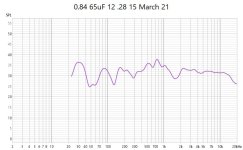
Results did not look much better, and do not measure well, but sounded much better; vocals now good, and overall sound is good.
I am most definitely hearing a lot of the performance of say the Salk Bepure 2; great bass quality and quantity, excellent transparency and focus, good tonality, very good imaging.
But it is not right, the peak and dip are bad, so more work is needed.
I will keep this xover as it is now, as the sound is good, and it will be my benchmark.
I doubt if I can do better with the simple xover so I plan these.
I will try a 3rd order butterworh, as this is the D'appolito way; it models well. It looks as if it may fix the dip without causing a peak. I will start with the standard values, this may have enough BSC at 0.66mH.
Also I will try 2nd/3rd order as I have but with a small notch to take down the 500-1k region; this also allows the cap on the bass to be reduced.
I am getting there, and enjoying it, and learning. Any help appreciated.
Thanks!
First, I remember a comment (Norman Tracy?) that a good designer using average drivers will usually beat an amateur using SOTA drivers.
I think it was said or implied that modelling of the crossover might get a reasonable result, but will not get you to a great speaker.
Herb Reichert said similar about valve amps, roughly from memory:
Some people think if they take a standard circuit, build it really well with top quality components they will get a great amp. Life is not that simple. If lucky, they might get a good amp, but to get to 'great' you have to suffer!
I know Herb's statement is true; it took a lot of effort to develop the expertise to get to (possibly) great valve gear.
I am finding that the comment about speakers is equally true. I have been suffering (but enjoying the journey).
Good modelling of the cabinet volume and port tuning did give excellent results, but this was because I know how to factor in the amp Zout, essential for a SET amp. I also took note of info about box volumes for the Purifi; I ended up with slightly larger volume and lower tuning, which I have used before. I noted comments about low tuning, extended bass shelf, working well. I find that it does; bass is fast, tight, tuneful, and goes very low. No trace of any of the issues that SET amps often have. Evidently the Purifi drivers are well suited to this arrangement. Allowing for internals, I have about 42 litres for 2 drivers, tuned to 27 Hz. I started with 24Hz, not sure which is best, I will revisit this.
I have been struggling with the crossover.
In setting BSC, I increased the inductor on the bass to increase the BSC, ending up with 0.8mH. For reference, the SEAS MTM uses 1.2mH.
Here I made a mistake; as the inductor change alters the xover point, I reduced the cap on the bass to correct this.
The sound was good in many ways, but I noticed on one CD that the vocal was not right; seemed like not enough fundamental. Once I had heard that, I could notice it (though to a lesser extent) on other CDs.
Measurement showed it up, 550 to 1100 Hz was at a higher level than 150 to 500Hz, which can be seen on above FR plots; but now it was more.
But also, there was more of a dip at 1800Hz.
Trying things in Xsim did not give good results, it was possible to improve either one but that made the other worse.
I ended up with a bit more on the inductor (0.84mH) and on the cap (65uF, looks a lot, but 2 drivers remember). Also cap 2 on the tweeter increased to 15uF.

Results did not look much better, and do not measure well, but sounded much better; vocals now good, and overall sound is good.
I am most definitely hearing a lot of the performance of say the Salk Bepure 2; great bass quality and quantity, excellent transparency and focus, good tonality, very good imaging.
But it is not right, the peak and dip are bad, so more work is needed.
I will keep this xover as it is now, as the sound is good, and it will be my benchmark.
I doubt if I can do better with the simple xover so I plan these.
I will try a 3rd order butterworh, as this is the D'appolito way; it models well. It looks as if it may fix the dip without causing a peak. I will start with the standard values, this may have enough BSC at 0.66mH.
Also I will try 2nd/3rd order as I have but with a small notch to take down the 500-1k region; this also allows the cap on the bass to be reduced.
I am getting there, and enjoying it, and learning. Any help appreciated.
Thanks!
I can also try a normal L - R parallel BSC circuit and reducing the value of the series inductor. I looked into this when initially planning the crossover, but it did not seem good. The SEAS MTM speaker did not need this, just careful setting of the simple series inductor worked well. It seems this way is not good enough for the Purifi, as it seems harder to get the low bass, lower voice (150-200 Hz approx) and 500-1000 ranges in balance.
It is said that the Purifi is not that easy to work with, it seems I am finding this so.
But I have things to try; it is a good learning process.
It is said that the Purifi is not that easy to work with, it seems I am finding this so.
But I have things to try; it is a good learning process.